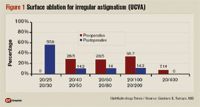Article
Surface ablation recommended for irregular astigmatism
San Diego-Surface ablation techniques such as PRK and LASEK can be considered in eyes with highly irregular astigmatism that have previously undergone LASIK or RK, according to Gustavo E. Tamayo, MD, who spoke during the annual meeting of the American Society of Cataract and Refractive Surgery.

In the past, previous corneal surgery was a contraindication for surface procedures because of the risk of inducing irregular healing as well as corneal haze. Now, with the use of mitomycin-C 0.02% (Mutamycin, Bristol-Myers Oncology) for 40 seconds after the ablation, the fear of developing haze that impairs visual acuity has been eliminated, explained Dr. Tamayo, a refractive surgeon with the Bogota Laser Refractive Institute, Bogota, Colombia.
Choosing the appropriate technique is especially important in cases of highly irregular corneas.
The decision to avoid LASIK is based on numerous reasons, including the fact that highly irregular corneas are prone to produce irregular flaps because of the uneven protrusion through the suction ring. In addition, extremely flat or steep corneas can produce irregular or buttonholed flaps. Loss of suction is often encountered in these cases as well.
In these previously operated eyes, there may not be enough stromal tissue for LASIK.

For patients with keratoconus, produc-tion of a LASIK flap is contraindicated, regardless of the amount of correction, Dr. Tamayo explained.
In these cases, Dr. Tamayo will proceed with surface ablation and leave behind 300 µm of untouched stroma.
Treating irregular corneas Dr. Tamayo presented data on his surface ablation techniques for three different patient populations with highly irregular corneas. Sixteen eyes had been treated with LASIK and the ablation was decentered in thin corneas. Twenty-four eyes had post-LASIK flap complications.
In the last group, 22 eyes had post-incisional surgery (RK). The mean follow-up was 20.8 months, ranging from 8.5 to 24.6 months.
For eyes with previous flaps, Dr. Tamayo recommended the use of the butterfly LASEK technique, using regular alcohol 30% for 40 seconds.
He starts the flap in the center of the cornea, being sure not to disturb the periphery. After removing the epithelial flap, Dr. Tamayo uses the Custom Contoured Ablation Pattern (C-Cap) method with either the VISX STAR S3 or S4 excimer laser for these eyes with irregular astigmatism. Then mitomycin-C 0.02% is applied for 40 seconds and washed away. The epithelial flap is replaced and a bandage contact lens is used for 1 week.

Newsletter
Don’t miss out—get Ophthalmology Times updates on the latest clinical advancements and expert interviews, straight to your inbox.




